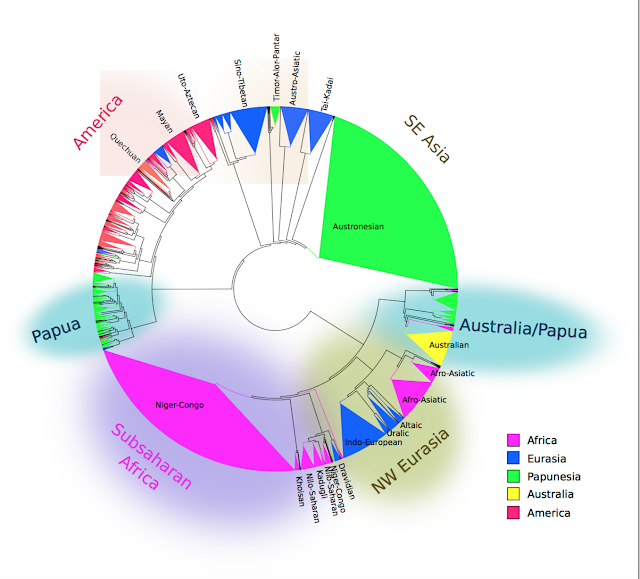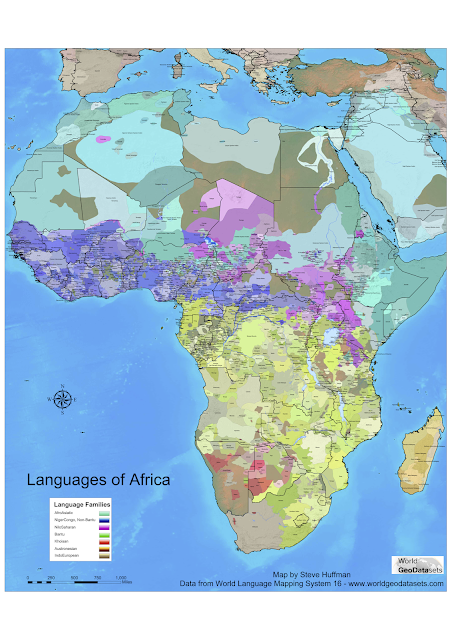The World Atlas of Universal Grammar
The World Atlas of Universal Grammar is an ongoing project documenting features of languages, by a team of more than eight authors. Each feature is a structural property that describes one aspect of cross-linguistic homogeneity. A feature has between 0 and 87178291200 values, shown by different colours on the maps. Here is a sample of the features listed by author.
Does the language reverse the order of words in a sentence
to form a question?
Yes No
Does the language employ musical melodies for words and
major/minor keys for polarity?
Yes No
Is the language made up only of two-word utterances, with larger compositional meanings deduced from pragmatics?
Yes No
Is it the ‘language’ of bee dance?
Yes No
Does the language specify grammatical relations not in terms
of agent and patient, but in terms of evolutionarily significant relationships (predator-prey,
eater-food, enemy-ally, permissible-impermissible sexual partners, etc.)?
Yes No
Is the language similar to the banter among New Guinea highlanders in the film of their first contact with the rest of the world, or the prattle of little girls in a Tokyo playground?
Yes No
Is it a ‘rational’ language spoken in a utopian commune, lacking arbitrary signs larger than a phoneme and allowing the meaning of any word to be deduced from its phonology?
Is the language similar to the banter among New Guinea highlanders in the film of their first contact with the rest of the world, or the prattle of little girls in a Tokyo playground?
Yes No
Is it a ‘rational’ language spoken in a utopian commune, lacking arbitrary signs larger than a phoneme and allowing the meaning of any word to be deduced from its phonology?
Yes No
Mark
Baker
Does the language have obligatory subject and
object-agreement on the verb, free word order, and object incorporation, as well as prohibiting reflexive pronouns and indefinite nominals?
Yes No
Noam Chomsky
How closely does the language resemble what a superbly
competent engineer might have constructed, given certain design specifications?
Richard Kayne
Does the language have Subject-Verb-Object order?
Yes
Luigi Rizzi
What type of wh-movement does the language have?
Overt Covert
Guglielmo Cinque
Overt Covert
Guglielmo Cinque
What
is the ordering of noun and adjective, noun and numeral, noun and demonstrative, possessor and possessum, verb and object, and verb and subject?
Head-initial Head-final
Ian Roberts
Ian Roberts
Is there V-to-V movement?
Yes No
Does Force attract Fin?
Yes No
Which of the following realizes Force?
Merge Move Both Neither
Is it natural to hypothesize that the accusative form of the object is found when the object moves to SpecAgrOP, and therefore that the subject must have raised out of VP because it precedes the object, up to the lowest position available to the subject which is SpecTP, making the V higher than T and therefore in AgrS?
Yes No
Géraldine Legendre
Yes No
Géraldine Legendre
Rank these constraints in order of importance:
The highest A-specifier in the sentence must be filled
Lexical items must contribute to the interpretation of a
structure
Focused elements are aligned with the left edge of the VP
Focused elements are aligned with the left edge of the
clause
Minimal projection
Economy of expression
Adjunction
No morphology
Obligatory heads
No lexical movement
Optional locative specifier
Optional manner specifier
Optional reason specifier
Economy of expression
Adjunction
No morphology
Obligatory heads
No lexical movement
Optional locative specifier
Optional manner specifier
Optional reason specifier
STAY
David Pesetsky
Does the language have case marking?
Yes No
If not, is it a Bantu language that can drop the nominal augment on nouns if they are preverbal and raised, but not if they are unraised?
Further reading: WALS, Pinker, Baker, Chomsky, Kayne, Rizzi, Cinque, Roberts, Legendre, Pesetsky.
Image links: World Phonotactics Database, Seuren Chomsky's Minimalism.
Cross-linguistic projects in generative grammar: SSWL, LanGeLin
David Pesetsky
Does the language have case marking?
Yes No
If not, is it a Bantu language that can drop the nominal augment on nouns if they are preverbal and raised, but not if they are unraised?
Yes No
So it does have case marking after all!
Yes No
Could this finding get published in Science, be reported as an AP news item, and end up as a theme for a joke by a late-night talk-show host?
Yes NoFurther reading: WALS, Pinker, Baker, Chomsky, Kayne, Rizzi, Cinque, Roberts, Legendre, Pesetsky.
Image links: World Phonotactics Database, Seuren Chomsky's Minimalism.
Cross-linguistic projects in generative grammar: SSWL, LanGeLin





Comments
Post a Comment